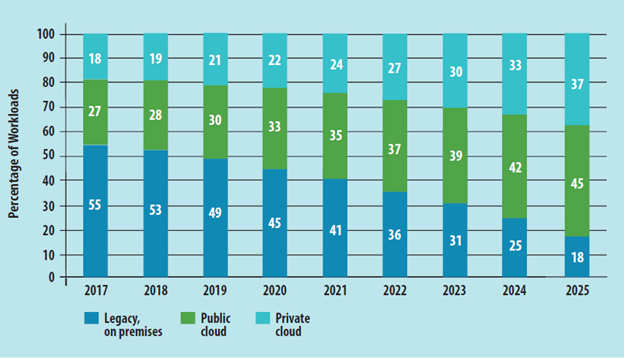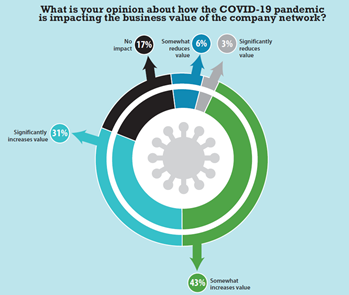Consumers and enterprises are at the beginning of a technological journey made possible by faster networks and data processing. Immersive retail, lifelike virtual and augmented reality, self-regulating manufacturing lines, networks of IoT sensors – these examples and more will require fast, ultra-low-latency connectivity and massive amounts of computing power. The convergence of cloud and edge is where opportunity – and possible trouble – lie for service providers.
A new analyst paper from ZK Research, VMware Addresses the End-to-End Edge Ecosystem, discusses the evolution of cloud and edge computing and the consequences for enterprises and service providers. Hybrid multi-cloud environments, where public clouds interoperate with private clouds and edge locations, are about to boom. ZK Research estimates that by 2025, enterprise workloads in legacy on-premises infrastructure will decline from around 40% today to 18% of total. Public and private cloud will run the other 82%.

The multi-cloud model is beginning to incorporate edge computing and shifting to a distributed multi-cloud model. In a distributed multi-cloud, workloads and data exist on virtual machines and containers, allowing public, private and edge locations to be managed and to appear to users as a single cloud.
“Edge computing brings compute power to new places, creating almost unlimited opportunity to disrupt every industry.”
Zeus Kerravala, VMware Addresses the End-to-End Edge Ecosystem
Edge computing – whether it is a telco edge, an IoT edge, or an enterprise edge – needs companion technologies for connectivity and adjacent services:
- 5G is faster and carries much larger payloads than its cellular predecessors, pushing edge computing into remote or hard-to-reach locations.
- Secure access service edge (SASE) enables cloud-delivered security anywhere, enabling security to run in the same locations as the apps and data it’s protecting.
- IoT data from billions of devices will create a cloud of information that must be processed in real time to gain its benefits.
- SD-WAN decouples network software services from hardware, providing fast and flexible software-defined connectivity to edge locations.
- Content delivery networks (CDNs) cache data to optimize its availability at the edge.
- Localized storage manages the huge amount of data required for real-time AI/ML, IoT, and other processing.
Business value and the new role of the service provider
The network is now considered more valuable for business than ever. In the ZK Research 2021 Hybrid Work Study, 74% of business and IT leaders surveyed said that the business value for enterprise networks has increased, especially after the pandemic made working from home or anywhere necessary.

Service providers have a historic opportunity to position themselves as essential partners in this new era where the network is an important business driver. However, this will require a shift in thinking. Traditionally, service providers provided the commodity “plumbing” of a network, while other companies provided the more valuable services that ran on top. With the move to distributed multi-cloud and the edge, service providers are virtualizing core network infrastructure and incorporating 5G connectivity to enable new revenue-generating services. They are also using SD-WAN and SASE for secure and resilient connectivity at the network edge.
Service providers that do not adapt well to this transition “risk being displaced by other vendors that were previously adjacent to the network,” according to the report. What is one of the secrets to success in this new world? The right technology partner.
VMware’s end-to-end edge portfolio

VMware has a turnkey, cloud-native portfolio that helps organizations run, manage, and secure edge-native apps across multiple clouds at both near edge and far edge locations. Enterprises can develop edge-native apps fast with secure, consistent infrastructure and operations. Because these solutions run on existing infrastructure, no time-consuming rip-and-replace is necessary.
“Today, VMware is unique in its ability to provide an end-to-end distributed cloud solution, making it ideal for service providers and enterprises that want to move into edge services.”
Zeus Kerravala, VMware Addresses the End-to-End Edge Ecosystem
The VMware edge portfolio includes:
- VMware SD-WAN™ for secure cloud-native connectivity with simplified operations and assured application performance
- VMware SASE™ combines the network performance benefits of VMware SD-WAN™ with integrated, cloud-delivered security services
- VMware Edge Compute Stack, a purpose-built, integrated VM and container-based stack that enables organizations to deploy and secure edge-native apps at the far edge
- VMware Telco Cloud Platform, a modernization solution that deploys cloud-native and virtual network function consistently, at web-scale speed, and without disruption.
- VMware vSphere, the gold standard of virtualization software
- VMware NSX, a software-defined virtualization and security platform for connectivity across distributed clouds
- VMware Tanzu Kubernetes Grid reliably runs containerized workloads across multi-cloud infrastructure
Download VMware Addresses the End-to-End Edge Ecosystem today to learn more about:
- Additional business and technical details about service provider opportunities
- The characteristics and challenges of distributed multi-cloud
- ZK Research’s recommendations for how service providers and enterprises should approach distributed computing
- How VMware’s comprehensive portfolio can make a difference for your business







